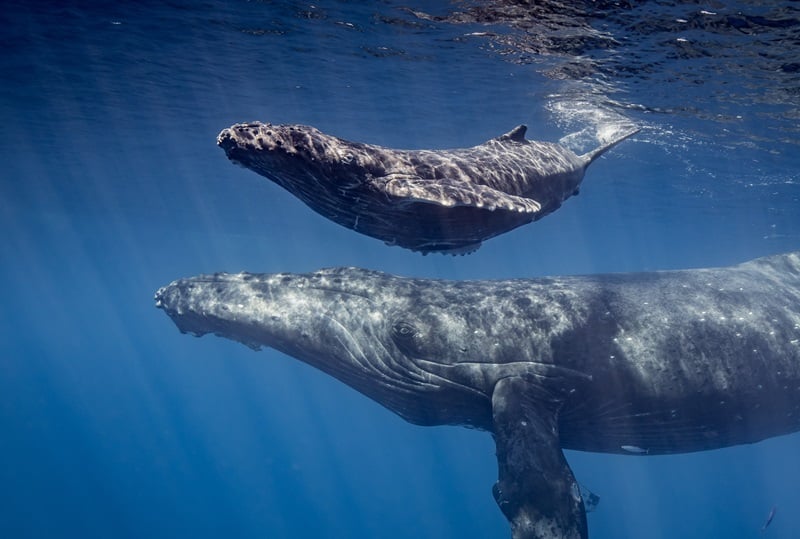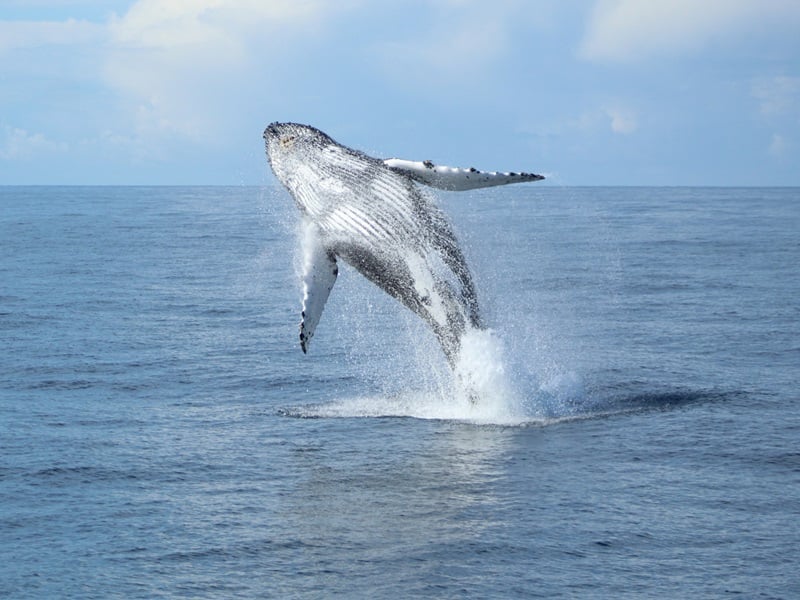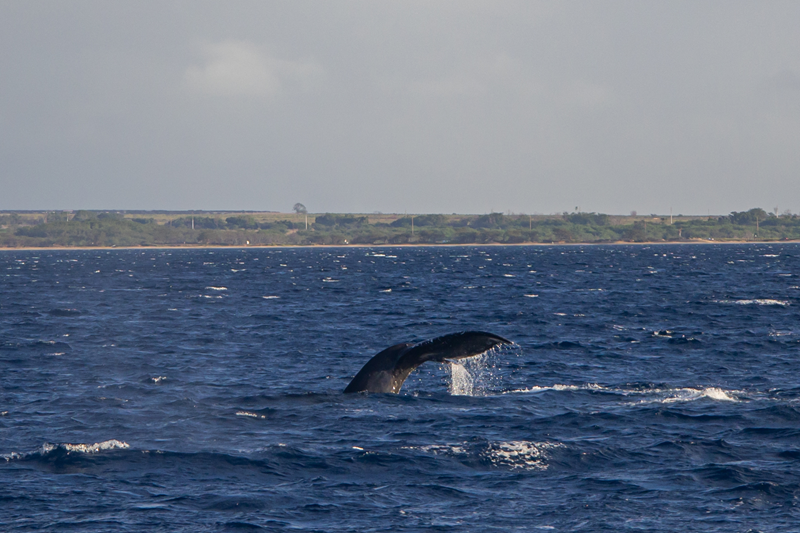The Magic of Whale Migration in Maui
Humpback whales, known as koholā in Hawaiian, undertake one of nature’s most remarkable journeys. These majestic creatures migrate from the icy feeding grounds of Alaska to the tropical waters of Hawaii, covering approximately 3,000 miles. This journey isn’t just for leisure—the warm, shallow waters around Maui are the ideal environment for mating, calving, and nurturing their young.
Maui is particularly special during whale season in Hawaii because of the shallow waters between Maui, Lanai, and Kaho’olawe, known as the Maui Nui Basin. This area is a designated sanctuary for humpback whales, offering a safe haven for these gentle giants. With an estimated 10,000 whales visiting Hawaii each year, the Maui Nui Basin hosts the largest concentration, making it the best place to witness whale migration in Maui.
When is Whale Season in Maui?
Whale season in Maui typically runs from mid-November to mid-April, with the peak viewing months being January through March. This is when you’re most likely to spot whales breaching, tail-slapping, and playing in the water. Early-season sightings can happen as early as October, while late-season stragglers might linger into May, but the best time to plan your trip is during the height of their activity.
Why do whales choose this time of year? The warm Hawaiian waters provide a perfect nursery for newborn calves. These waters lack predators like orcas and offer a mild environment where calves can gain strength before the long journey back to Alaska.
How to Experience Whale Migration in Maui
1. Whale Watching/Snorkeling Tours
One of the best ways to witness the whale migration in Maui is by joining a tour. These tours are led by knowledgeable captains and crew who provide fascinating insights into whale behavior and biology. While we don’t offer a specific whale watching tour, whales are often seen from the Lani Kai II when traveling to our snorkeling locations. Check out our morning and afternoon tour packages!
2. Shoreline Viewing
If you prefer to stay on land, there are plenty of places around Maui where you can see whales from the shore. Popular spots include:
• Papawai Point: Located along the Honoapiʻilani Highway, this lookout offers stunning views and frequent sightings.
• Kapalua Coastal Trail: A scenic trail where you can spot whales while enjoying Maui’s dramatic coastline.
• Makena Beach: A quieter location where you might catch glimpses of whales in the distance.
Bring a pair of binoculars for a closer look and enjoy the magical experience of watching whales breach against the backdrop of Maui’s azure waters.
3. Kayaking and Paddleboarding
For a more adventurous experience, consider kayaking or paddleboarding during whale season in Maui. Guided tours are available, offering a unique perspective as you glide across the water near these gentle giants. Always maintain a respectful distance to ensure both your safety and the whales’ well-being.
Schnorcheln im Molokini-Krater
Ready for an underwater adventure you won’t soon forget? Snorkel with schools of tropical fish, encounter graceful sea turtles, and witness the beauty of a thriving coral reef. Book your Molokini Crater snorkeling tour today and experience the magic of Maui’s underwater paradise!
Whale Behaviors to Watch For
The humpback whales’ captivating behaviors make every sighting special. Here are some of the most common actions you might see:
• Breaching: This dramatic leap out of the water is a sight to behold. Scientists believe breaching may be a form of communication or simply play.
• Tail Slapping: When a whale slaps its tail against the water, it creates a loud splash that can be heard from a distance.
• Pectoral Fin Slapping: With fins up to 15 feet long, humpbacks often wave or slap the water with their pectoral fins.
• Spyhopping: This behavior involves the whale lifting its head above the surface, seemingly to take a look around.
• Blowing: The spout of water vapor from a whale’s blowhole is often the first sign of a nearby whale.
Each behavior tells a story, and seeing them up close adds depth to your understanding of these incredible creatures.
The Cultural Significance of Whales in Hawaii
In Hawaiian culture, whales are deeply respected and considered guardians of the ocean. The Hawaiian word for whale, koholā, is associated with family, strength, and protection. Whales appear in many Hawaiian legends, and their annual migration is seen as a symbol of renewal and connection.
Participating in a whale watching tour or simply observing from the shore offers an opportunity to connect not only with nature but also with the rich cultural heritage of Hawaii.
Conservation and Responsible Whale Watching
The humpback whales’ journey to Hawaii is a triumph of nature, but it also highlights the importance of conservation. These whales were once endangered due to whaling but have made a significant recovery thanks to international protections. However, they still face threats such as climate change, marine debris, and ship strikes.
When experiencing whale migration in Maui, it’s crucial to follow guidelines to protect the whales:
• Maintain a safe distance of at least 100 yards.
• Choose eco-certified tour operators who prioritize marine life safety.
• Avoid loud noises or sudden movements that could disturb the whales.
By respecting these guidelines, you can ensure that future generations will continue to enjoy whale season in Hawaii.
Fun Facts About Humpback Whales
1. Size and Weight: Humpbacks can grow up to 60 feet long and weigh as much as 40 tons.
2. Songs of the Sea: Male humpback whales are known for their complex songs, which can last up to 20 minutes and are thought to be part of mating rituals.
3. Calf Growth: A newborn calf can gain up to 100 pounds per day, thanks to its mother’s nutrient-rich milk.
4. Longevity: Humpback whales can live up to 50 years or more.
These incredible facts make observing these creatures even more awe-inspiring.
Planning Your Trip During Whale Season in Maui
To make the most of your visit during whale season in Maui, consider the following:
• Buchen Sie frühzeitig: Tours and accommodations fill up quickly during peak whale season.
• Bring the Essentials: Sunscreen, polarized sunglasses, and a camera are must-haves.
• Learn About Whales: Familiarizing yourself with humpback whales’ behaviors will enhance your experience.
Conclusion: A Journey Worth Witnessing
The whale migration in Maui is a testament to the resilience and beauty of nature. Whether you’re on a boat tour, exploring the coastline, or paddling through the waters, the sight of humpback whales in their natural habitat is nothing short of magical. Beyond the spectacle, whale season offers an opportunity to connect with Hawaii’s rich cultural heritage and foster a deeper appreciation for marine life.
As you plan your visit during whale season in Hawaii, prepare to be awed by the grace and grandeur of these incredible creatures. Their presence in Maui’s waters is a reminder of the delicate balance of nature and the importance of protecting it for generations to come. We look forward to seeing you on our snorkeling tours for a chance to see these majestic creatures! Mahalo!
Schnorcheln Maui
Ready for an underwater adventure you won’t soon forget? Snorkel with schools of tropical fish, encounter graceful sea turtles, and witness the beauty of a thriving coral reef. Book your Maui Snorkeling Tour today and experience the magic of Maui’s underwater paradise!



